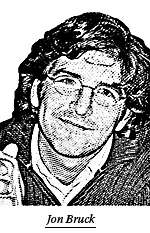« Photography 2.0: Raw Processing | Back to Home | History of Browsing Web Content »
January 06, 2005 Rapid Innovation
I met Jon Bruck at Que Tal, a coffee shop on Guerrero at 22nd Street, most notable for amount of natural light that  passes through the large windows. Jon wanted to show me the discHUB (his latest project) and talk to me about a concept called Rapid Innovation.
passes through the large windows. Jon wanted to show me the discHUB (his latest project) and talk to me about a concept called Rapid Innovation.
Before I get in to the specifics of Rapid Innovation, let me describe the existing landscape. Today, if you are an individual or a company without deep design resources, or if you are looking to create a new project which has no in-house staffing, you enlist the help of design firms such as Pentagram, IDEO or Frog Design. These firms do work internationally for the Fortune 100 and have a reputation for delivering high quality solutions.
The problem is that these firms are expensive. At the height of the dot com boom, it was rumored that Frog Design was charging $1M for a corporate logo. IDEO will layout a multi-phase plan for research, prototyping and testing, but just kicking off the first phase will run about a quarter of a million dollars. If you are Pepsi and are looking for a new toothpaste tube design, this expense is trivial. But what if you are an individual with a new idea for a way to build CD storage system? You’re not even sure if you really like your idea, so spending a lot of money is out of the question, but at the same time you’d like to explore it a little bit—poke at it for a while and see if there’s something about it that’s worth exploring more indepth. Similarly, if you’re working at a big company and have a small idea that you’d like to explore, you can’t go to your boss and ask for a quarter of a million dollars to work with IDEO, but you may be able to get a small experimental budget of a couple thousand dollars.
This is where Rapid Innovation comes in.
Rapid Innovation is a way of working with people to visualize and prototype a concept quickly and inexpensively. It allows the client to explore ideas and get questions answered without having to make a significant financial commitment. Rapid Innovation is like dating your idea. Going to a firm like Pentagram is like proposing marriage to your idea. In the dating world you get to explore and learn what works for you and what doesn’t. If you find something that clicks, you can propose marriage. But when you go to a big firm for design consulting you have to make such a significant investment of resources up front that it’s essentially like marrying your idea. It’s a serious commitment.
I’ve had the opportunity to work in a nimble, light-weight way at NASA and Microsoft. In both cases, I was able to build a prototype to help them visualize what they wanted in under 3 months. The total cost in both cases was nominal (in the area of $10K). The difference is that back then I wasn’t thinking about a system like Rapid Innovation explicitly.
Now that I’m thinking about Rapid Innovation explicitly, I’ve started to use the technique of delivering fast, low-cost idea visualizations not only with external clients, but also internally at Adobe. With the help of my boss, Bill Bachman, I’ve started to do three week stints with different product teams. I spent some time with the DVA team, then with Mark Hamburg, and most recently on Creative Suite 3. By staying nimble and moving quickly it’s forced me to operate as if I were working with a small budget. For a company like Adobe which is used to the marriage model, this is an approach that runs counter to the cultural norms, but if it proves successful it can help pave the way for a richer culture of prototyping.
Posted by johnnie at January 6, 2005 04:44 PM
Comments
Hey Johnnie!
Good to hear you've been doing some cool prototyping stuff for those Adobe chaps.
I've been following your site for the last few weeks now and am glad to see you're starting to make more regular entries. I don't have anything too interesting to add, just thought your site needed some comments.
Oh, and why would Pepsi need a toothpaste tube design? he he.
-mk
Posted by: Mark Kawano ![[TypeKey Profile Page]](http://www.johnniemanzari.com/nav-commenters.gif) at January 8, 2005 09:46 AM
at January 8, 2005 09:46 AM


